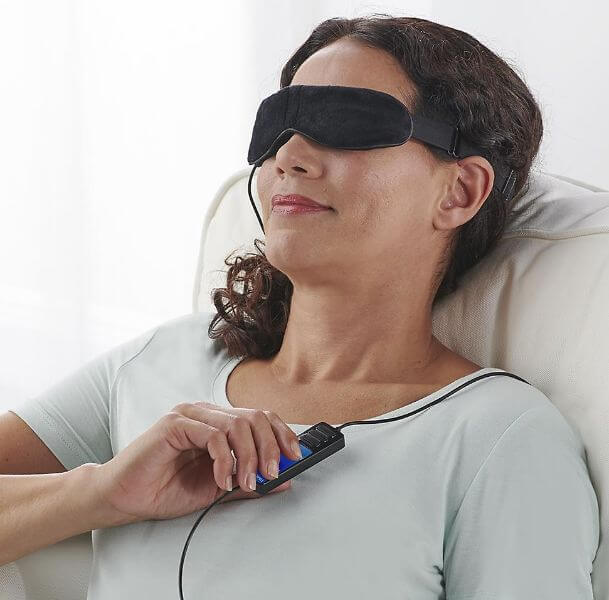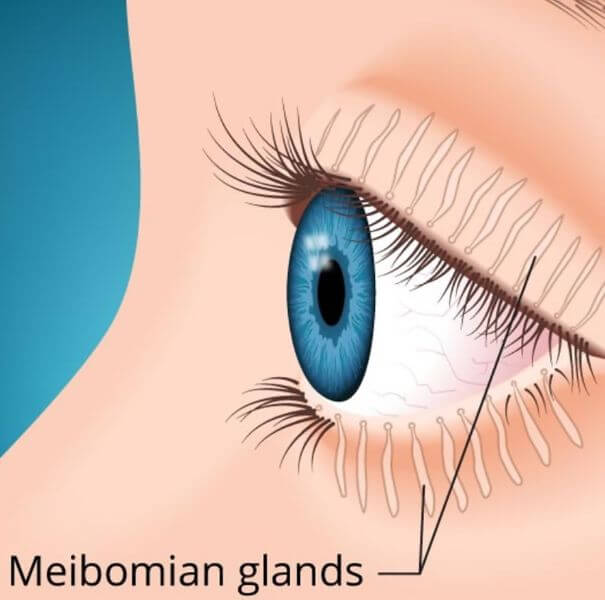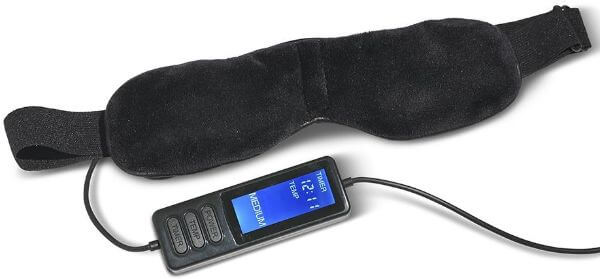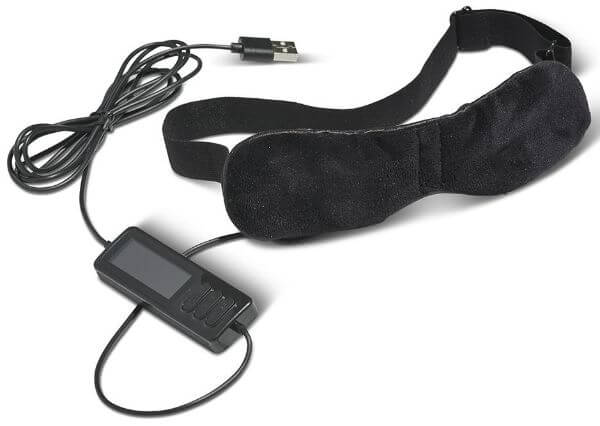These are the best heated eye mask for dry eyes and they are worth every penny!
They are developed by dry eye experts and recommended by ophthalmologists.

The electric heated mask maintains the ideal temperature to relieve dry eyes, MGD, and blepharitis.
Unlike other masks that have no temperature controls, this one warms to a constant temperature to release congealed oils that can accumulate and clog tear ducts.
A special thermal fabric is used to evenly disburse heat along the Meibomian glands.

These are very small glands in the margin of the eyelids and they secrete oil which coats the surface of our eyes and keeps the water component of our tears from drying out.
The mask has three temperature settings (110° F-135° F) and it heats up instantly. There is also a variable timer with auto shut-off.
You are supposed to use it for two 10-minute treatments per day.

It’s so light, you can sit up while wearing it and it will not slip down.
The cover is removable and washable, which is a great enhancement.
The only little downside is that the mask dose not have a “beep” sound to alert you the time is up. But, the mask will start cooling down, which is a sign that it has turned itself off. Or you can set a timer on your cell phone.
This is a truly remarkable heated mask for dry eyes! I like everything about it, from the comfortable fit to the temperature settings and timer.

Although it is a little bit expensive, it is well worth the price!
It performs exactly as it say it would.
What Causes Dry Eyes?
Having dry eyes is a lot more complicated than just having the occasional dry eye symptoms.
You may know this as the redness, gritty or burning sensations on the eyes .
But having dry eye syndrome where your eye becomes chronically or severely dry, that’s when the eye can become painful and even cause your vision to be blurry.
We are going to break down what causes dry eyes. because there’s a lot of confusion out there and we want to help you understand what dry eye is and ultimately how you and your doctor can work together to help cure your dry eyes.
When it comes to understanding exactly what causes dry eyes, the first thing that we want to review is the contents of the tear film
The easiest way to think of the tear film is in three layers.
There’s the lipid layer which helps protect your tears from evaporating. There’s the liquid component of the tear, called the aqueous layer of the tear, that’s mostly water, and then you have the mucous layer of the tear film which binds the aqueous or liquid component of the tears to the surface of the eye.
The aqueous component also contains electrolytes or salt and then it also contains proteins. That’s important because as the salt content changes of the liquid tear film, then that can contribute to a major component of dry eye disease.
Dry eye disease is categorized into three main cateogiries.
The first category is called aqueous deficient dry eye. That’s where you don’t produce enough of the liquid, aqueous component of your tear film.
Then you have an evaporative form of dry eye, where the tear film evaporates too quickly. You may still produce enough liquid, but the tears themselves are evaporating faster than you can produce it.
And then there is a mixed form, right in the middle between aqueous and evaporation. Studies show that about 90 percent of people who have dry eye disease, have some form of the mixed form of dry eye.
When it comes to the aqueous deficient dry eye, let’s cover some of the main causes for aqueous deficiency.
One of the first ones is hormone changes.
We know that a lot of people suffer from dry eyes later in lifetime. People can still have it when they’re younger, but usually people have it as they get into their 50s and above.
A lot of women tend to have dry eyes more than men and that has to do with testosterone level changes as we age. That’s why oftentimes women will get dry eyes about 20 to 25 years earlier before men do.
Next up is sensory block.
That’s where nerves within the eye are supposed to pick up sensations of dryness and send that signal to your brain and then back to your eye and the lacrimal glands to produce more tears,
Unfortunately for people who’ve either had trauma or some sort of infection, like a virus, or potentially other refractive procedures, such as LASIK, these different receptors, these nerves, can be severed and they don’t function the same way. In fact, they don’t even grow back properly.
You’re not getting that feedback mechanism to your brain to produce more tears. That is why a lot of people having LASIK eye surgery can end up with really severe forms of dry eye.
Another major cause of aqueous deficiency has to do with medications. If you’re somebody who takes a lot of systemic medications for different diseases, these medications oftentimes do dry out the body.
Most notably are going to be antihistamines, such as oral antihistamines you take for allergies as well as any medications for high blood pressure. These medications are most famous for drying out the body.
Usually you have to urinate more often and so you end up with just not having enough liquid in your body to help produce tears.
So it’s important to remember to drink lots of water.
Next up for the aqueous deficient forms of dry eye is that of autoimmune and inflammatory causes.
One of the most famous autoimmune conditions that cause this form of dry eye is one called Sjogren’s syndrome. In short, Sjogren’s syndrome is an autoimmune condition that attacks your parroted glands, your saliva secreting glands in your cheeks, but it also attacks your lacrimal gland and prevents it from making mucus.
The other component are inflammatory causes.
This can be things like arthritis, such as rheumatoid arthritis and this can cause an inflammatory cascade that essentially turns off your lacrimal gland and you don’t produce as much tears.
This of course is not the complete list of everything that causes aqueous deficiency, but these are by far the most common culprits for this condition.
Now let’s go on to evaporative forms of dry eye.
This is really concerning for a lot of eye care professionals because this is not just causing issues later in life for older individuals like aqueous deficiency, but in fact, evaporative forms of dry eye are starting to show up in younger individuals, even people in their younger teen years.
When it comes to the evaporative forms of dry eye, there is an environmental component and we’re talking about the humidity, temperature and airflow.
When there’s a really low humidity, especially in the winter time, the furnaces are on and that usually causes the humidity to be very low and that tear film is going to evaporate quicker into the air.
Temperature in general, if it’s hotter outside or indoors, it’s going to cause your tear film to evaporate faster.
And then airflow. So if you have air conditioning, a fan or maybe you’re outside and wind is blowing against your eyes, your tear film is going to evaporate quicker and then you’re going to end up with more dryness.
This next one is really important because this affects so many people, even younger individuals who are on things like the computer all day.
That is poor blink rate and poor eyelid closure.
When we’re sitting just in conversation, we typically blink around 20 times a minute. But as soon as we go on a device, we’re looking at a phone, a computer screen, a tablet, then your blink rate drops to only about five times per minute and that can be significant because then your eyes are going to be open and your tear film is going to be evaporating much faster.
In addition to just a poor blink rate, oftentimes people don’t close their eyes completely.
They only complete half blink, they blink enough for their eyelid to come just below their pupil, so brain thinks that they’ve closed their eyes, but in fact they’ve left about one third to one half of their entire eyelid open and that’s always exposed to air so the tear film is constantly evaporating very quickly.
Some people even have eyelid closure issues while they’re sleeping, which is called lagophthalmos and that means their eyes are open all night long and their eyes are just drying out very quickly.
You may have that experience where you wake up in the morning and your eyes are very gritty and sandy and almost feel like they are stuck together when you first open your eyelids.
What’s even more important about understanding how poor blink rate plays a role in dry eyes is the effect on your oil glands within the eye.
The oil glands are called the Meibomian glands, they live in your eyelids and every time you blink, these oil glands secrete a little bit of oil.
Remember that lipid layer on the tear film that we discussed earlier, that tear lipid layer is going to protect those tears from evaporating.
If you’re not blinking enough that means these oil glands, which are activated by the full blink on the eye, then you’re not getting enough oil secreted to even protect the tears from evaporating.
Furthermore, if you’re not blinking enough and you’re not blinking completely, then these oils can get trapped in the oil glands and they can sit there, they can solidify into more of a wax instead of an oil and then they can even go rancid causing inflammation of the eyelids and that is called the Meibomian gland dysfunction or MGD.
That is a huge component of dry eye disease. In fact about 80 percent of all dry eye sufferers have MGD to some extent.
Above mentioned heated eye mask for dry eyes is great at relieving this condition.
Finally contact lens wear can play a role in dry eye syndrome.
Namely because it does increase the evaporative component of dry eye because the tear film spreads unevenly on top of those contacts. It can cause sensory changes or adaption to the surface of the eye, so your brain isn’t getting the same sensory feedback loop.
You can also have a poor blink rate and then the contact lenses themselves can not only soak up tears on the surface of the eye but if they’re not fitting properly, they can damage surface cells on the front of the eye named goblet cells.
Next up we’re going to touch on the inflammatory cycle of dry eye and why the inflammatory cycle makes dry eye syndrome so difficult to treat.
The reason dry eye syndrome can become so severe and chronic for people is that the inflammatory cycle will kick in.
That’s where aqueous deficient and evaporative forms of dry eye start to change the salt content of your tear film.
What happens when the tear film is evaporating, you’re losing the liquid portion of your tears, but the salt content of the tears stays behind.
If the salt content stays behind, it’s going higher and higher in salt, and they call that having a hyper osmolarity.
That means the equilibrium of the surface of the eye has shifted away from normal and that can cause damage to cell membranes on the surface of the eye. In extreme cases it even looks like someone took sandpaper and scratched the front surface of the eye.
After that, every time you blink, because the eye is so dry and irritated, it’s almost like you have an open wound that you’re scratching every time your eyelid is coming up and down. That further aggravates the eye, releasing inflammatory proteins, which basically just starts the cycle over again.
The inflammatory proteins can trigger inflammatory causes for aqueous deficiency. They can cause inflammation on the oil glands on the surface of the eyelid, which again cause evaporation. Even the inflammatory proteins can contribute to damage of the ocular surface.
That’s why there are different treatments for dry eye and why so many of those treatments focus on first controlling the inflammatory cycle along with treating the root causes.
We highly recommend that you try the best heated eye mask for dry eyes. It really works.
